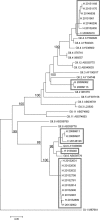New real-time PCR detects prolonged norovirus excretion in highly immunosuppressed patients and children
- PMID: 19625473
- PMCID: PMC2738087
- DOI: 10.1128/JCM.00448-09
New real-time PCR detects prolonged norovirus excretion in highly immunosuppressed patients and children
Abstract
Noroviruses (NoV) are a major cause of epidemic nonbacterial gastroenteritis and affect all age groups worldwide. Three of five NoV genogroups, namely, genogroup I (GI), GII, and GIV, are associated with human disease. Unfortunately, these genogroups demonstrate a high degree of sequence diversity, complicating the design of pan-NoV diagnostic PCR tests. To decrease the risk of false-negative test results, we have developed a new one-step real-time TaqMan reverse transcription-PCR protocol. This protocol detects all human NoV genogroups in one reaction with a sensitivity of 400 virus genome equivalents/reaction for both GI and GII. The use of in vitro-transcribed NoV RNA as an external standard allows (semi)quantification of viral loads in samples. In a retrospective analysis of 206 stool samples from 77 patient episodes, the duration of NoV excretion and the amount of virus excreted were determined. Twenty (26.0%) of these episodes lasted longer than 10 days. Univariate risk factor analysis revealed the patient status after organ transplantation (odds ratio [OR], 7.49 [95% confidence interval, 2.06 to 28.32]; P < 0.001), immunosuppression (OR, 9.19 [95% confidence interval, 2.50 to 35.39]; P < 0.001), and age of less than 10 years (OR, 4.58 [95% confidence interval, 1.36 to 15.77]; P = 0.004) as risk factors for a NoV excretion period of more than 10 days. These findings were confirmed by time-dependent Kaplan-Meier analyses, whereas multivariate Cox regression analyses identified immunosuppression as the sole risk factor. Surprisingly, in contrast to the excretion periods, the viral loads in stools did not increase in connection with age or immunosuppressive status. This fact may be one important piece in the pattern of high-level NoV transmissibility and may have an impact on the development of transmission prevention strategies.
Figures





Similar articles
-
Emergence and predominance of norovirus GII.17 in Huzhou, China, 2014-2015.Virol J. 2015 Sep 11;12:139. doi: 10.1186/s12985-015-0370-9. Virol J. 2015. PMID: 26362650 Free PMC article.
-
Norovirus in feces and nasopharyngeal swab of children with and without acute gastroenteritis symptoms: First report of GI.5 in Brazil and GI.3 in nasopharyngeal swab.J Clin Virol. 2017 Feb;87:60-66. doi: 10.1016/j.jcv.2016.12.009. Epub 2016 Dec 21. J Clin Virol. 2017. PMID: 28033513
-
Clinical and epidemiological characteristics of norovirus gastroenteritis among hospitalized children in Lebanon.World J Gastroenterol. 2016 Dec 28;22(48):10557-10565. doi: 10.3748/wjg.v22.i48.10557. World J Gastroenterol. 2016. PMID: 28082807 Free PMC article.
-
Diagnostic Accuracy of Immunochromatographic Tests for the Detection of Norovirus in Stool Specimens: a Systematic Review and Meta-Analysis.Microbiol Spectr. 2021 Sep 3;9(1):e0046721. doi: 10.1128/Spectrum.00467-21. Epub 2021 Jul 7. Microbiol Spectr. 2021. PMID: 34232095 Free PMC article.
-
Norovirus in Cancer Patients: A Review.Open Forum Infect Dis. 2021 Mar 14;8(6):ofab126. doi: 10.1093/ofid/ofab126. eCollection 2021 Jun. Open Forum Infect Dis. 2021. PMID: 34189156 Free PMC article. Review.
Cited by
-
The role of prolonged viral gastrointestinal infections in the development of immunodeficiency-related enteropathy.Clin Rev Allergy Immunol. 2012 Feb;42(1):79-91. doi: 10.1007/s12016-011-8292-9. Clin Rev Allergy Immunol. 2012. PMID: 22116710 Review.
-
Unrecognized norovirus infections in health care institutions and their clinical impact.J Clin Microbiol. 2012 Sep;50(9):3040-5. doi: 10.1128/JCM.00908-12. Epub 2012 Jul 11. J Clin Microbiol. 2012. PMID: 22785184 Free PMC article.
-
Akt Plays Differential Roles during the Life Cycles of Acute and Persistent Murine Norovirus Strains in Macrophages.J Virol. 2022 Feb 9;96(3):e0192321. doi: 10.1128/JVI.01923-21. Epub 2021 Nov 17. J Virol. 2022. PMID: 34787460 Free PMC article.
-
The dynamics of norovirus outbreak epidemics: recent insights.Int J Environ Res Public Health. 2011 Apr;8(4):1141-9. doi: 10.3390/ijerph8041141. Epub 2011 Apr 15. Int J Environ Res Public Health. 2011. PMID: 21695033 Free PMC article. Review.
-
Epidemiology, Clinical Features, and Unusual Complications of Norovirus Infection in Taiwan: What We Know after Rotavirus Vaccines.Pathogens. 2022 Apr 9;11(4):451. doi: 10.3390/pathogens11040451. Pathogens. 2022. PMID: 35456126 Free PMC article. Review.
References
-
- Bellmunt, A., G. May, R. Zell, P. Pring-Akerblom, W. Verhagen, and A. Heim. 1999. Evolution of poliovirus type I during 5.5 years of prolonged enteral replication in an immunodeficient patient. Virology 265178-184. - PubMed
-
- Estes, M. K., B. V. Prasad, and R. L. Atmar. 2006. Noroviruses everywhere: has something changed? Curr. Opin. Infect. Dis. 19467-474. - PubMed
-
- Gallimore, C. I., D. Lewis, C. Taylor, A. Cant, A. Gennery, and J. J. Gray. 2004. Chronic excretion of a norovirus in a child with cartilage hair hypoplasia (CHH). J. Clin. Virol. 30196-204. - PubMed
MeSH terms
Substances
Associated data
- Actions
LinkOut - more resources
Full Text Sources
Medical

